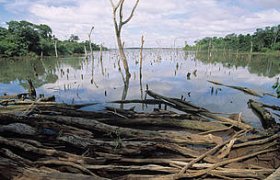Wetlands Environmental Issues
Wetlands are critical in supporting the healthy waters and diverse wildlife of the Chesapeake Bay watershed. Located where land meets water, wetlands act like a sponge, soaking up storm surges and trapping polluted runoff. Wetlands also provide habitat to hundreds of fish, birds, mammals and invertebrates. But development, invasive species and sea level rise threaten these important areas. Protecting and restoring wetlands is a key way to promote clean water, healthy habitats and a restored Bay.
What is a wetland?
Located where land meets water, wetlands are vital habitats in the Chesapeake Bay watershed. Wetlands act like a sponge, soaking up stormwater and dampening storm surges. By trapping polluted runoff, wetlands help slow of the flow of nutrients, sediment and chemical contaminants into rivers, streams and the Bay. Hundreds of species of fish, birds, mammals and invertebrates depend on wetlands, and humans rely on wetlands to support recreational fishing and hunting across the watershed.
But shoreline development, sea level rise and invasive species pose major threats to these critical habitats: development along beaches and shorelines blocks the creation of further wetland habitat and creates excess sediment; sea level rise floods wetlands with saltwater, destroying plants faster than they can populate higher ground; and invasive plants and animals can crowd out native species or damage wetland habitat.
What types of wetlands are found in the Chesapeake Bay region?
A wetland is defined by its soils and vegetation. Some wetlands may be saturated with water throughout the year, while others are not always visibly wet. All wetlands are dominated by “hydrophytes”—plants that are adapted for life in wet soils—and have hydric soils, meaning they are periodically saturated or flooded.
Two broad categories of wetlands are found in the Chesapeake Bay watershed:
- Tidal, or estuarine, wetlands are flooded with salt or brackish water when tides rise. Tidal wetlands are found along the shores of the Bay and the tidal portions of streams, creeks and rivers.
- Non-tidal, or palustrine, wetlands contain fresh water and make up 86 percent of the wetlands in the watershed. Palustrine wetlands are located on floodplains bordering streams and rivers, along the shorelines of lakes and ponds or covering broad, flat areas where water may collect (such as many areas on the Delmarva peninsula).
Wetlands can be further distinguished by the varieties of plants that grow there:
- Emergent wetlands, often called marshes or wet meadows, are made up of grasses, sedges and other leafy, non-woody plants.
- Shrub wetlands, known as bogs or shrub swamps, are characterized by low- to medium-height woody plants.
- Forested wetlands, including wooded swamps and low-lying hardwood forests near rivers, are dominated by trees. Sixty-eight percent of the wetlands in the Bay watershed are forested.
Why are wetlands important?
Wetlands provide critical habitat for hundreds of species of fish, birds, mammals and invertebrates while improving the health of the Bay by collecting and storing flood waters, filtering polluted runoff and weakening storm surges. Wetlands also help protect shorelines and property, as well as provide opportunities for outdoor activities.
Wetlands improve and protect the Chesapeake Bay's health
Situated between the land and the water, wetlands act as buffers by slowing the flow of pollutants into the Bay and its tributaries. As polluted stormwater runs off the land and passes through wetlands, the trees and grasses filter and absorb nutrients, sediment and chemical contaminants before these pollutants can flow to nearby waterways.
Wetlands also help control erosion. Just like a sponge, wetlands soak up and hold large amounts of flood water and stormwater runoff, releasing the water slowly over time. Wetlands along the edges of streams, creeks, rivers and the Bay stabilize shorelines and protect properties from floods and wave action.










